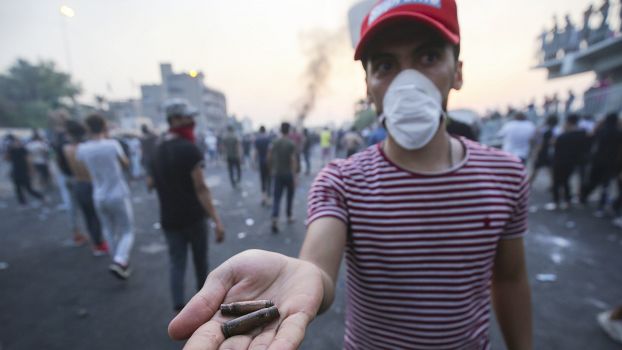
An assessment of current developments in Iraq from a left-wing activist after the beginning of the ongoing protests on 1 October 2019. The conversation took place via phone call on 3 October after the Iraqi government shut down all Internet access.
There are many different causes for the current protests, many of which date back years: the socio-economic situation in Iraq has not improved since the demonstrations in 2018, unemployment rates have gone up. Currently, there are about 13 million people unemployed in Iraq, mostly due to the lack of investments and the general state of the Iraqi economy. It is mainly the state apparatus itself that offers opportunities for employment.
The outbreak of demonstrations in Egypt two weeks ago encouraged many activists in Iraq to call for protests in Baghdad on 1 October. During the months leading up to this moment, the Iraqi government took all measures to prevent and suppress previous demonstrations, organized by various groups like engineers, students of educational studies, and veterinarians. Mainly five groups set out to organize demonstrations in Baghdad over the course of the last six months, attended by approximately 500 people. The government’s violent reaction to these protests sparked anger throughout the country – for a large part of the Iraqi population, it seemed unfathomable why the protesters, members of a higher income group with access to education, and their legitimate demands were met with such violence. Furthermore, the government released Abd Al-Wahhab Al-Saadeh, one of the military leaders during the fight against ISIS in Mosul. His popularity in Iraq is predominantly due to his non-confessional alignments – which sets him apart from many other popular figures.
The wave of anger and frustration finally led to the call for protests on 1 October, answered by a large number of people joining the demonstrations despite the fact that they had been publicly banned by several parties and political organization like the Iraqi Communist Party, the Sadrist Movement, and the Worker-Communist Party of Iraq[1] – the latter of which had been taking part in protests over the previous years. Nevertheless, precisely this kind of reluctance demonstrated by the well-established parties encouraged many people to join the protests by strengthening their non-sectarian and secular positions. Moreover, the protesters’ demands struck a chord with many Iraqis (and not just specific groups or sects) and their basic demands to end corruption, poverty, and unemployment.
Conversation and translation by Miriam Younes and Sarah Wansa of the RLS Beirut Office.
The day of the demonstration, Tuesday, 1 October, was deliberately set on that date: the majority of organizers and attendees were unemployed and Tuesday is a normal working day, but the unemployed do not have work. What started as a small demonstration turned into a mass protest with between 800,000 and one million participants. Violent countermeasures taken by the security forces from the outset caught many people by surprise. The police and army not only used tear gas but fired live ammunition at the protesters.
Despite this extreme course of action, people continued to protest on the streets until the security forces tracked them to their homes. This continued until 4:00 the following day when approximately 500 people had been killed and more than 1,000 injured. Images started to circulate showing children who had suffered severe injuries and burns from the security forces’ weapons. The protests spread to other parts of the country, several governmental buildings (in Maysan), the headquarters of political parties, and mosques in the Babil and Maysan Governorates in South-Eastern Iraq. In addition to the official security forces, several militias joined the clashes, attacked demonstrators and followed them to their homes. In Ghazaliyeh, one of Bagdad’s poor neighbourhoods, violent clashes broke out between the Kharasani militia and the Sawa’ed clan, after the district was overrun by the militia. Internet services have been shut down and armed forces continue to attack and kill protesters in their homes.
Two days ago, two of our friends were shot in their house after they assisted in emergency care during a demonstration in Basra: Sarah Taleb and Hussein Adel, a young couple active in the protest movement, were murdered with 10 gunshots.
These protestors are peaceful. The violence that we have come to witness is the violence of the government and its armed forces. They are answering the call for basic rights with gunfire and tanks and curfews, they’ve declared a national state of emergency and are cutting everybody off from the Internet. But despite all that, we will continue the only way we know how to: revolution.
[1] In the meantime the Worker-Communist Party changed its position and supported the demonstrations. (note of the auhtors)